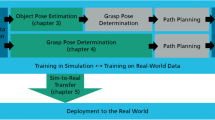Abstract
Conventional approaches to robotic planning have focused on the resolution theorem prover, using general-purpose search heuristics, with the desired goal expressed in terms of logical calculus. These approaches suffer from several drawbacks; one major problem encountered in these approaches is the speed of planning. In this paper we describe an approach of applying supervised learning to robotic planning. The learning system is an intermediate one between rote learning and generalization learning, and is based on the concept of analogy. Simulation examples of various robot tasks are presented to demonstrate the significant increase in the systems's planning speed and to compare it with some existing systems.
Similar content being viewed by others
References
K. S. Fu, “Learning control systems-review and outlook,”IEEE Trans. Autom. Control AC-15:210–221 (April 1970).
K. S. Fu, “Learning control systems and intelligent control systems: an intersection of Artificial Intelligence and Automatic Control,”IEEE Trans. Autom. Control AC-16:70–72 (February 1971).
R. E. Fikes and N. J. Nilsson, “strips: A New Approach to the Application of Theorem Proving to Problem Solving,” Second International Joint Conference on Artificial Intelligence (IJCAI) (September 1971), pp. 608–620.
R. E. Fikes, P. E. Hart, and N. J. Nilsson, “Some new directions in robot problem solving,” inMachine Intelligence, Vol. 7, B. Meltzer and D. Michie, eds. (1972), pp. 405–430.
R. E. Fikes, P. E. Hart, and N. J. Nilsson, “Learning and executing generalized robot plans,”Artif. Intell. 3:251–288 (1972).
E. D. Sacerdoti, “Planning in a Hierarchy of Abstraction Spaces,” Third IJCAI (1973), pp. 412–422.
J. Derksen, J. F. Rulifson, and R. J. Woldinger, “The QA4 Language Applied to Robot Planning,”Proceedings of the AFIPS Conference, Vol. 41 (1972), pp. 1181–1192.
J. Doran, “Planning and robots,” inMachine Intelligence, Vol. 5, B. Meltzer and D. Michie, eds. (1970).
I. Goldstein, “Planning Paradigms-Knowledge for Organizing Models into Programs,” inComputer Oriented Learning System (NATO Advanced Study Institute, 1974).
C. C. Green, “Application of Theorem Proving to Problem Solving,” First IJCAI (1969), pp. 219–239.
C. Hewitt, “Description and theoretical analysis (using schemata) of planner: a language for proving theorems and manipulating models in a robot,” MIT-AI-TR-258 (April 1972).
A. Horman, “How a computer system can learn,”IEEE Spectrum, 110–119 (July 1964).
R. E. Kling, “A paradigm for reasoning by analogy,”Artif. Intell. 2:147–178 1971.
M. Minsky, “A Framework for Representing Knowledge,” MIT-AI Lab, memo #306 (June 1974).
N. J. Nilsson, “A Hierarchical Robot Planning and Execution System,” SRI-AI Technical Note -76 (1953).
L. Siklossy, “Procedural Learning in World of Robots,” inComputer Oriented Learning Processes (NATO Advanced Study Institute, 1974), pp. 423–436.
R. Simmons and B. Bruce, “Some Relations Between Predicate Calculus and Semantic Net Representations of Discourse,” Second IJCAI (1971), pp. 524–530.
R. F. Simmons, “Semantic networks: Their computation and use for understanding english sentences,” inComputer Models of Thought and Language, R. C. Schank and K. M. Colby, eds. (1973), pp. 63–113.
P. H. Winston, “Learning Structural Descriptions from Examples,” MIT-AI Lab, Technical Report #231 (September 1970.)
D. A. Waterman, “Generalization learning techniques for automating the learning of Heuristics,”Artif. Intell. 1:121–170 (1970).
S. Tangwongsan and K. S. Fu, “An application of learning to robotic planning,” Technical Report TR-EE 77-7, Purdue University (December 1976.)
Author information
Authors and Affiliations
Additional information
This work was supported by the National Science Foundation grant ENG-74-17586.
Rights and permissions
About this article
Cite this article
Tangwongsan, S., Fu, K.S. An application of learning to robotic planning. International Journal of Computer and Information Sciences 8, 303–333 (1979). https://doi.org/10.1007/BF00993056
Received:
Revised:
Issue Date:
DOI: https://doi.org/10.1007/BF00993056




